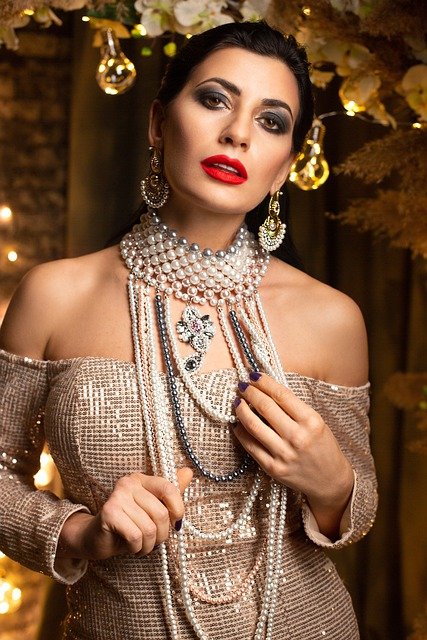

Jewellery is typically an elegant metal object with intricate stones and decoration that represents the wearer’s class and style. It reflects a person’s personality and personal style. It really is a work of art. Contemporary jewelled items include watches, earrings, necklaces, brooches, bracelets, anklets, sterling rings, statement rings, cocktail rings, ear studs, nose pins, and nose rings, as well as sterling rings, statement rings, ear studs, cocktail rings and nose rings.
Women wear jewellery to enhance their appearance and express their personal style. It gives women more strength and makes them feel more secure and optimistic. For a woman, such jewellery pieces, such as a wedding cocktail ring, serve as reminders of a unique experience. Other times, jewellery is worn as a family badge and passed down through the generations as a family heirloom. Women often purchase jewellery as a hedge, hoping to protect their funds and resell at a higher profit. Some women still use jewellery to mask their superstitions and fears. It provides them with a sense of safety.
115,000 years ago, a prehistoric Neanderthal (a prior generation of extinct archaic humans) produced the first piece of jewellery out of seashells and beads. Since then, several cultures have arrived and adopted their culture’s jewellery. The Egyptian dynasty, for example, created their jewellery 5000 years ago, which is known for its large designs with massive detailing, made entirely of gold and expensive and rare stones. It was a sign of a religious and political influence and dominance.
Gold, amethysts, pearls, and emeralds were also used by the Greeks in 500 BC to reflect a vibrant but elegant generation of jewellery worn to represent wealth and prestige. Romans wore delicate patterns to fend off the evil eye, specifically brooches, to tie their clothes. Many cultures merged in Europe during the Renaissance, and only the most delicate, intricate, and beautiful type of jewellery emerged to reflect the grandeur and magnificence of the greatest civilization of artists and their admirers that ever existed.
Women desire to be tough. They want something that reminds them of their toughness while still demonstrating it to the rest of the world. It has little to do with crime. It’s about feeling safe and secure. Jewellery, the peculiarly intimate accessory, has long been associated with spiritual, mental, and even physical security.
Armor may also be worn as clothing, but jewellery is more personal. It feels stronger than, say, a tailored jacket when you wear it next to your skin. It’s a history that dates back to the beginning of time and spans cultures, with prayer beads and amulets on one side and amulets on the other.
Designers and analysts say it’s not shocking that women are turning to jewellery for a sense of security and self-expression when many believe advances in equal rights and civil rights are under pressure. “Women are responding to the current sense of danger in realistic ways, whether through protests like the Women’s March or through the use of fashion and crafts to express themselves.
With a few exceptions, the patriarchal culture evolved into more accepting and tolerant women with the passage of time. Women today work alongside men in order to contribute financially to their families and community. Their style, clothing, and accessories are all formal, much like men’s. A working woman has her own personal style statement, which can be seen in her appearance in front of business associates or coworkers.
The most critical aspect of a working woman’s style statement is her jewellery. She doesn’t want to seem too bland and uninteresting. She doesn’t want to be overbearing. She needs to exude the same amount of elegance and sophistication that her job necessitates. She aspires to be charismatic and confident.
All of her dreams come true when she wears tiny, delicate, and elegant jewellery. A nice watch and glasses, along with small earrings, a thin necklace, and trim rings such as a cocktail ring, a sterling ring, or a statement ring, make a true style statement for her. She should accessorise herself for office events with a bold piece of jewellery worn with an elegant dress, creating a massive style statement in front of her coworkers. Jewellery can act as a protective shield for women in the workplace, shielding them from insecurities and anxieties. For her, it is a source of power.
If you are interested in jewellery designing or want to make a career in jewellery designing, education from a good institution is necessary for bagging a decent jewellery designer salary. JD Institute is one of the best institutes providing jewellery designing courses with reasonable jewellery designing fees such as diploma in jewellery designing with industry-based curriculum or approach to stand apart from the crowd paving a path where there is a lot of scope of jewellery designing. JD Institute shares a vision of providing the best facilities, technology and resources so that its students are not restricted from any external factor in achieving their goals. Due to their extraordinary contribution to education and record-breaking placement of 99% ith their students working for top companies and making a name for themselves in the industry, they have been awarded with a various token of recognition such as the international glory award, leaders in education award, the times’ power icon award and many more. Candidates are chosen based on a general aptitude test, or GAT, developed by the department to evaluate the candidate’s artistic or creative abilities. Through providing practical advice, the JD council will assist you in staying in touch with the college and other students after graduation. It represents the organization’s mission of assisting members in expanding their business opportunities by providing a well-organized, positive, and skilled referral programme that allows them to establish meaningful and long-term relationships with quality industry professionals. Enroll now to take advantage of this fantastic opportunity!